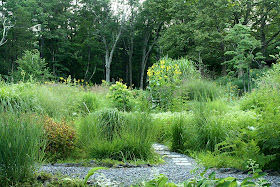 |
| Willowwood Arboretum: small garden and edge |
I felt like a third thumb.
Not knowing what to expect, but intrigued by a day-long outing to three former grand estates, now part of the Morris County park system in New Jersey, I signed up with the Garden Writers Association for its Region I and II event. Friday was the day. The temperature in New York's Central Park reached 104. It may have only been 102 in Morris County, but it was a killer.
The three former estates we visited -- Willowwood, Bamboo Brook, and the Frelinghuysen Arboretum (to be the subject of another post) -- all offered a mix of formal gardens and informal meadows and woodlands. What I found of most interest were the edges, where the "gardened" gardens merged with the surrounding fields. The entrance road at Willowwood wound through acres of grasses, golden rod, monarda, and milkweed. It was a beautiful site, and I would have liked to stop to explore it, but we were given no time for edgy exploration, only some well orchestrated presentations on the history of the estates, photos of the founders, and tours of the more formal grounds immediately surrounding the historic buildings.
Bamboo Brook Outdoor Education Center, formerly known as Merchiston Farm and home to Martha Brookes Hutcheson, one of America's first female landscape architects, was particularly stunning with its restoration of the garden's water features, which take advantage of the landscape's dramatic changes in elevation to harvest storm water from the surrounding landscape, collecting it in an Upper Water, from which it flows down a rock lined stream to a large round pool situated in a natural bowl of land.
 |
| Restored brook and circular pool designed by Martha Brookes Hutcheson |
The pool is treated in an Italinate manner with four symmetrical approach ramps and steps creating two strong visual axes, one of which looks out across a ha-ha to a grassy meadow ... another edge.
There was much talk of axes.
Back home, as I peruse the Willowwood brochure, I see walks are offered in many edgy areas.
So I'm wondering why we were only shown the tame side of things, but not the edges. Perhaps because it costs a ton of money to restore these vast estates, and the staff wants garden writers to write about that. To help the cause. I agree. It is a worthy cause, one not often enough recognized in the good ole USA, so you should click on the links above and go visit these places.
I actually find it quite amazing that a county government (with much private fundraising, I'm sure) operates not one, but three, such estates as part of the public parks system. The Frelinghuysen Arboretum -- perhaps the grandest of the estates, though the least personal -- even has a library with rare florilegia and herbals dating back to the 16th century.
It has edges too. One was a "demonstration" storm water detention basin planted in native plants appropriate to such a wet, sometimes flooded, site. That was one of the highlights of the day, for me, though apparently not of much interest to anyone else.
 |
| Can you make a storm water detention basin look pretty? Yes, you can. |
Like I said, a third thumb.





































































